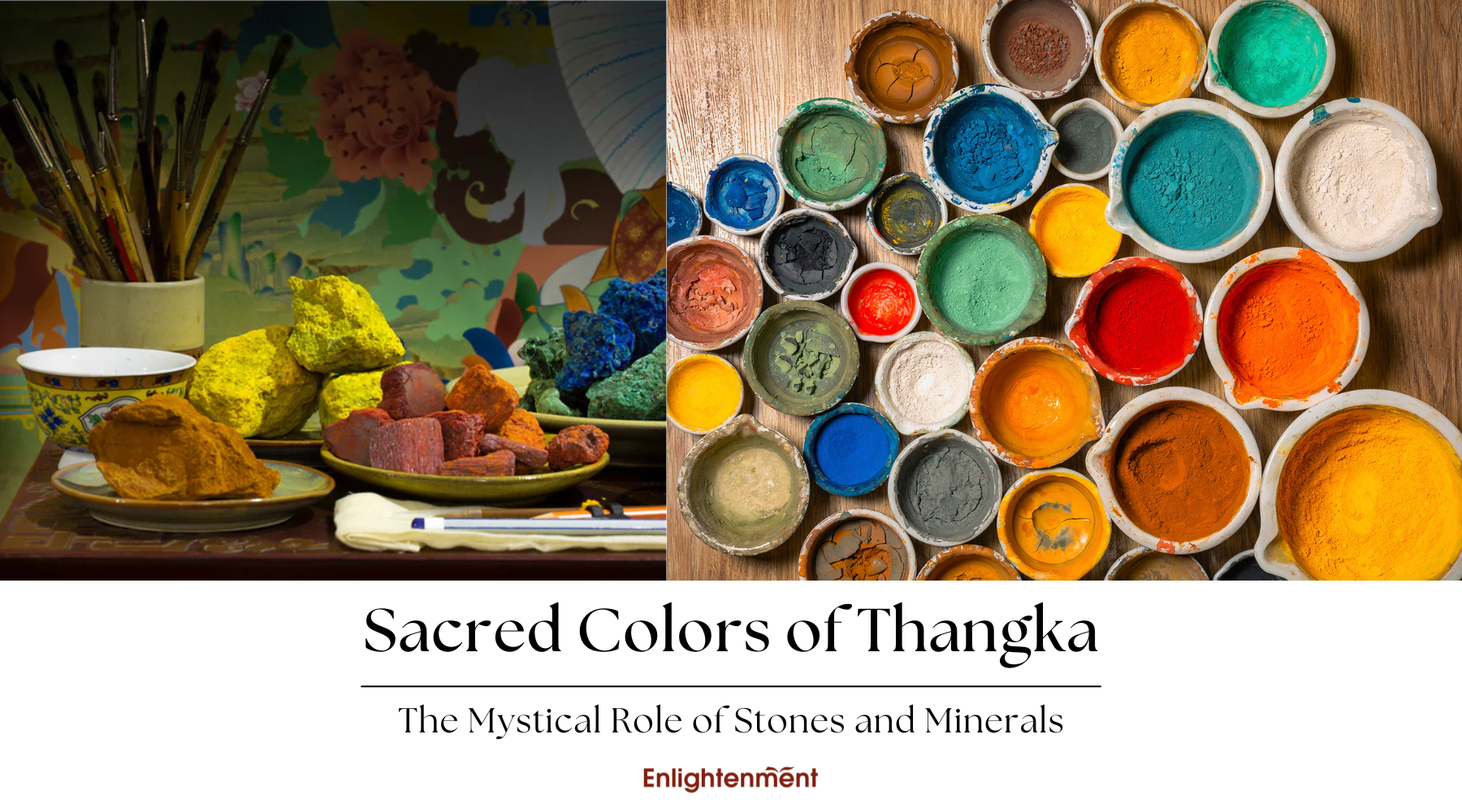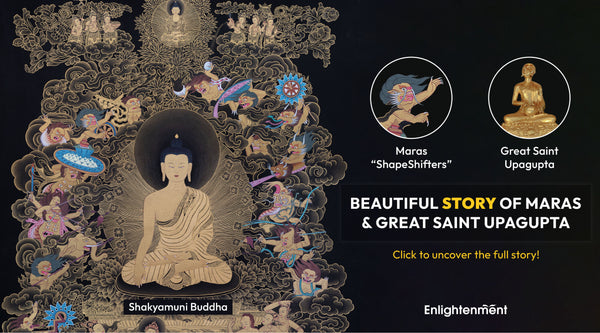Natural Stones Enhance the Sacred Colors of Thangka
The art of Thangka often incorporates sacred stones and minerals that result in the celebrated vivid colors and deep spiritual significance. And those colors create a powerful connection between the physical and divine realms. Thus, thangka has become more than an artistic expression; it is a portal connecting the earthly and the divine. Every stroke in these sacred scrolls carries profound meaning, transcending aesthetics to touch realms of devotion and meditation.
At the heart of this tradition lies the ancient use of stone colors and pigments derived from nature’s minerals that infuse each painting with vibrant energy and spiritual significance. From their symbolic meanings to their ritualistic preparation, each hue tells a story of the Earth and the cosmos. In this read, explore the intricate and sacred role of st9one and mineral colors in Thangka.
Thangka Is A Canvas of Spirituality

Thangka paintings are sacred tools designed to guide the soul toward enlightenment rather than just decorative scrolls. Depicting deities, mandalas, and Buddhist cosmology, these artworks serve as aids for meditation, prayer, and teaching. As they are painted on cotton or silk, they often employ natural pigments sourced from plants, minerals, and stones, embodying the essence of the natural world.
The meticulous process of creating a Thangka is both an artistic and a spiritual discipline. Artists have approached this craft with reverence, blending skill with devotion. Thus, the use of stone and mineral pigments passed down through generations adds a layer of sanctity to the practice, ensuring that each Thangka resonates with spiritual power.
The Symbolism of Stone Colors in Thangka Art
Stone colors in Thangka art are not chosen at random; rather, each pigment carries a unique energy and meaning. They correspond to the spiritual qualities of the depicted figures and themes. These natural pigments are derived from minerals that bring a divine vibrancy to the paintings.
1. Red: The Color of Transformation

The red color is derived from cinnabar or realgar. It embodies power, passion, and vitality while symbolizing the fire that burns away ignorance and ego, transforming the soul toward enlightenment. In Thangkas, red often adorns deities like Kurukulla, emphasizing their intense yet compassionate nature. The shimmering, stone-based pigment reflects dynamic energy, reminding viewers that passion when directed wisely, fuels spiritual growth.
2. Gold: The Light of Enlightenment

The color Gold is frequently found in powdered form. It represents perfection, prudence, and heavenly luminosity. It highlights the haloes, the scriptures, and the garments of the sanctified. Just like the sun that shines bright onto everything without any bias, gold epitomizes the quintessential form of enlightenment, which is sheer insight rooted in wisdom. This color adds vibrancy to the artwork and turns it into a painting and not just a picture but a spiritual guide.
3. Blue: The Depth of Tranquility

Lapis lazuli is the source behind Thangka’s deep blue hues. The color blue carries the essence of the sky and the vastness of the universe. Blue symbolizes tranquility, protection, and boundless wisdom. Deities like Buddha Akshobhya are associated with serenity and unshakable resolve. Hence, they are often depicted in hues of blue, channeling their calming and protective energies through the canvas.
4. Green: The Balance of Healing

Crafted from malachite, green represents harmony, fertility, and renewal. It symbolizes the perfect balance of opposites—compassion and wisdom, stillness and movement. In depictions of Tara, the goddess of compassion and healing, green embodies her power to restore peace and balance, both within and in the external world.
5. White: The Purity of Wisdom

White, often derived from powdered shells, is the color of purity, clarity, and transformation. It represents the potential for enlightenment, the blank slate ready to be filled with spiritual wisdom. Thangkas use white to emphasize the serene expressions of Buddhas and bodhisattvas, guiding viewers toward the ultimate truth.
The Ritual of Creating Stone Pigments
The preparation of thangka pigments is a sacred act in itself. Stones like Lapis Lazuli and Cinnabar are carefully chosen, crushed into fine powders in a stone mortar, and mixed with natural binders like yak-hide glue. This labor-intensive process requires patience, skill, and spiritual focus. Each step, from grinding to mixing, is accompanied by prayers and meditation, transforming the act into an offering to the divine.
The use of these pigments isn’t just about creating vibrant hues; it’s about drawing out the spiritual energy of the stones. This energy infuses the Thangka with life, making it a vessel for blessings and divine presence.
The Modern Relevance of Stone and Mineral Colors

In today’s world, the tradition of using natural stone and mineral pigments faces challenges. Synthetic pigments, though convenient, lack the spiritual resonance of their natural counterparts. Yet, many Tibetan monasteries and artists remain committed to preserving this sacred art form, teaching younger generations the ancient techniques.
This preservation effort isn’t just about safeguarding a cultural heritage; it’s about maintaining the spiritual integrity of Thangka art. By using such colors obtained from natural sources, artists ensure that their work remains a conduit for meditation, healing, and divine connection. And this is where the experienced and devoted Thangka artists in the Images of Enlightenment come forward.
Our team ensures that the thangkas have all the correct emblems, attributes, and iconography while corresponding to your Sadhana or meditation guideline and adhering to high-quality natural stone and mineral colors.
Click on this link to contact us to place a special custom order thangka for your Vajrayana practice.
Why Stone and Mineral Colors Matter in Thangka

The use of mineral colors in Thangka isn’t just about aesthetics—it’s about creating a spiritual bridge. Each pigment resonates with the energy of its source, drawing viewers into the sacred realms depicted on the canvas. Whether it’s the passionate red of cinnabar or the tranquil blue of lapis lazuli, these colors are more than visual—they are alive, imbued with meaning and purpose.
The following list includes the names of the minerals and the pigment they create:
Conclusion: The Eternal Legacy of Stones and Mineral Colors in Thangka

Stone colors in Thangka are a testament to the profound relationship between nature, spirituality, and creativity. Each pigment carries the energy of the Earth and the intentions of the artist, creating a sacred space where viewers can connect with the divine. By understanding the significance of these colors, we deepen our appreciation for Thangka art—not just as a visual experience but as a spiritual journey.
The next time you encounter a Thangka, remember this: its colors are not merely painted. They are vessels of sacred meaning, whispering the stories of the cosmos and guiding you toward enlightenment. Through these natural colors, the Thangka becomes a living prayer, an eternal reminder of the divine harmony that binds us all.


